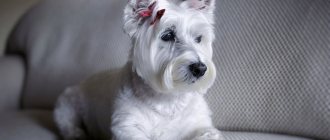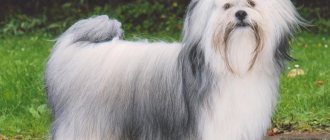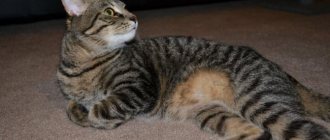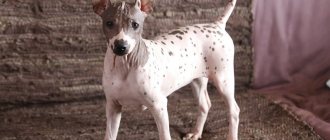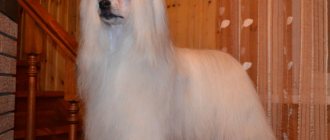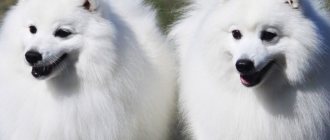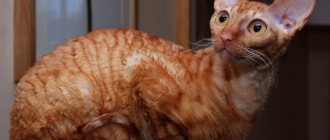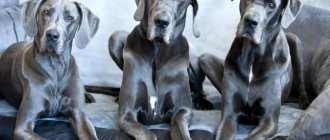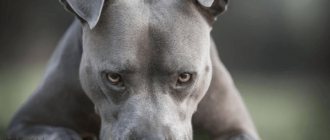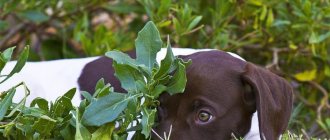Breed characteristics
| Short description | |
| Origin: | Japan |
| Conditions of detention: | Apartment or private house |
| Purpose: | Companion dog, decorative |
| Color: | White with red or black spots, there is a tricolor - white and black with red tan |
| Wool length: | from 8 to 15 cm |
| Adult dog size: | height 23 – 25 cm, weight 2 – 3 kg |
| Average life expectancy: | About 14 years old |
| Walk: | Daily walking is recommended |
| Physical activity needs: | Low physical activity needs |
| Fédération Cynologique Internationale (FIC) classification: | Group 9 – decorative and companion dogs; Section 8 – Japanese Chin and Pekingese |
| Puppy price: | Wide range of prices from 10,000 to 60,000, depending on the titles of the parents |
Content Features
Japanese Chin dogs do not require high physical activity. A short jog or even a calm walk once a day is enough for them. If it is not possible to walk the dog, it can go to the litter box and limit itself to indoor games. The pet feels comfortable even in small apartments. In extreme heat, it is better not to go for walks, as the dog may get heatstroke.
The breed tolerates cold quite well and does not require special insulation.
Since the dog's neck is delicate, it is better to use a harness instead of a leash.
History of the origin of the species
The Japanese Chin is a breed whose history is covered in secrets and legends. According to one version, these are the sacred dogs of Buddha, according to another, they are descendants of Tibetan toys, according to the third, the direct heirs of Chinese Pekingese.
In ancient Japan, Chins were not considered dogs at all; they were treated like royalty. The dogs lived in large gilded cages, each of them had a servant who fulfilled all the whims of the hin. Little aristocrats expect the same attitude towards themselves today.
It is believed that Japanese Chins were fed rice and sake to prevent the breed from growing too large.
In past centuries, peasants were not allowed to keep chins. The punishment was very severe - even the death penalty. Chins adorned only the famous palaces of China, Japan and Korea; they were symbols of an honorable place in high society. The only obligation of the miniature representatives of the canine elite was to amuse and please the upper strata of the population.
The Japanese Empire gave these dogs as a gift as a sign of special respect for foreign ambassadors. Thus, by the beginning of the 19th century, chinas began to appear in the palaces of Europe. The Japanese Chin was appreciated in European countries; Western society was in solidarity with Eastern society. This breed was truly a suitable companion for monarchs .
In 1853, Japan opened its borders to trade, and sailors began exporting representatives of this wonderful breed to the United States in droves. Then Japanese chins became available to all segments of society.
After the First World War, the Japanese spaniel, as the chin was then called, was on the verge of extinction . In the 50s, American and English clubs of breed connoisseurs united and began work on restoring the royal dogs. As a result of this selection, the world saw a modern type of Japanese Chin.
In 1977, the breed was recognized by the International Canine Federation, and the first standard was drawn up. In the same year, the Japanese spaniel became known as the chin.
In Japan, they still believe that the chin protects the house and protects it from evil spirits.
Origin of the breed
The Chinese Chin dog breed was developed by people related to the imperial family. The Forbidden City of Beijing revered these animals, considering them sacred. Different families preferred to breed pets with a color, thickness of coat and size of the chin that was different from the neighboring palaces. Standards could even differentiate a dog's behavior. It was believed that it was impossible to look directly into the eyes of an animal, so as not to offend.
Only as a result of long-term selection can this type of dog be reproduced. Its miniature size and resistance to diseases, cheerful disposition and beautiful colors distinguish the chin from its similar relatives. The symmetrical coloring of the muzzle and ears, leaving a white stripe across the entire forehead, remains unchanged from generation to generation.
Over many centuries, the species has undergone changes in temperament and appearance, but veneration in its homeland has remained unchanged. There the dog is considered the animal of Buddha. The gradual spread of the Chinese Chin breed led to popularity in Japanese palaces. There was no ban on breeding outside the walls of temples. After the opening of the Japanese islands to the world, the favorites of the imperial families end up in Europe on ships.
Hin is an excellent watchman, able to distinguish friends from enemies. He loves to play; the dog’s peculiar character makes you think that it is trained. In fact, this is just a very intelligent and sensitive companion, capable of quickly accepting the rules of the game and behavior. Shows feelings in a peculiar way - touchy, but easy-going. Be sure to demonstrate his attitude towards others. Majestic behavior is reminiscent of descent from royal blood. The closest relatives of this dog are Pekingese, Japanese spaniels and Beijing palace dogs. It is believed that the Chinese Chin comes from the above mentioned breeds.
Miniature replicas of lions, sacred animals of Buddhists, are not considered dogs in their homeland. According to the inhabitants of the Land of the Rising Sun, only evil and sinful people could turn into dogs and deserve to be treated accordingly. Pekingese and chins are completely different creatures of unearthly origin and deserve special treatment. Possessing an affectionate disposition, they are focused on communicating with people and need family comfort.
Distinctive features
The main distinguishing features of the Japanese Chin are:
- General form. A compact dog, harmoniously built, ideally the length of the body is equal to the height at the withers; in females a more elongated format is acceptable. The gait is light, the posture is proud.
- Height. Height at withers for males is 24 – 26 cm, for females 23 – 25 cm
- Head. The head is large relative to the body, spherical in shape. The ears are set high, hanging, long, triangular in shape. The eyes are large, round, almost black in color, the look is a little distracted, located at the level of the nose, always on a red or black background. The nose is black; in individuals with red spots, the pigment of the nose matches the color of the spots, the nostrils are slightly raised up. The occipital protuberance is moderately pronounced, the transition from the forehead to the nose is sharp and pronounced.
- Muzzle. Very short, wide, slightly tapering towards the nose. The bite can be either straight or scissor; recently the trend has been toward overbite.
- Neck. Moderate length, without dewlap, smoothly blending into the withers.
- Frame. The ribs are moderately convex, the chest is relatively wide, falling just below the line of the elbows. The back is short, the lower back is rounded, the stomach is tucked. In proportion to its size, the dog looks quite strong.
- Limbs. The shoulders are straight, the bones are thin. Hind limbs with well-defined angles. The front paws are straight, set parallel, with the metacarpus splayed apart.
- Tail. Set on high, well furred, lies on the back, when stressed the dog lowers it.
- Coat and color. The coat is long, soft, straight, thick, the undercoat is very weakly expressed, longer on the collar, tail and pants than throughout the entire body. Colors are white with black or red spots, a tricolor color option is possible. A prerequisite is that the ears are solid black or red, the remaining spots can be randomly located.
- Sexual dimorphism. It is expressed moderately, but sexual imbalance is common (males in the bitch type and vice versa).
Chinese Chin. Description of breed, character and appearance
This cheerful creature of miniature size - from 20 cm and weighing 1.8 kg - is a unique animal that looks very much like a living toy. This dog is a family favorite, very active and playful. The smallest weighs only 900 grams with a height of 18 cm. The classic size is up to 25 cm and 2 kg. With a height at the withers of 28 cm, the dog can weigh more, about 5-6 kg. These sizes are comparable to the size of an adult cat. Dogs of this breed weighing 6 kg are considered gigantic for their species. Life expectancy is on average 12–13 years, less often – 15.
A small animal with a large head, huge, widely spaced, slanting black eyes. He has a flat nose and triangular floppy ears covered with beautiful long hair. The graceful shaggy tail is curved towards the back. The color is most often white with black, less often – red or pure black. The proud posture and amazed expression on his face attracts the attention of even those who are indifferent to dogs.
The toy dog, infinitely devoted to his owner, is sad when he is apart, even if it is not for a long time. He may even stop eating until his best friend and breadwinner returns. Welcomes the return with stormy emotions and canine delight, showing his love and devotion with all his might. It shares joy and sadness with its owner, often taking on his illness. There are cases where a dog died along with its owner.
Barks very rarely. Therefore, it happens in all public places where animals are not prohibited, including the theater. The dog may be under the owner’s arm and remain unnoticed. The ban on miniature dogs does not apply to many places, such as museums, exhibitions and galleries. Banks and libraries have come to terms with the presence of the pocket dog. These qualities attract many owners of a unique dog. The Chinese Chin, the photo of which is presented below, can easily be called a pocket dog.
Possessing a subtle, vulnerable nature, she requires special self-love. The dog wants to feel the most loved, smart, beautiful. It is these feelings that add jealousy to the character and resentment. It is worth noting that such a dog is vulnerable and cheerful at the same time. I would also like to say that there are various translations of the name of the breed. For example, some translate it as “a sacred jewel on the mistress’s sleeve.”
Photo of an adult dog
Haircut of the Japanese Chin: a necessity or a tribute to fashion
Despite the fact that these dogs are blessed with a magnificent, long and silky coat, it does not require complex care. The natural appearance of the animal is very much appreciated, especially at exhibitions, so attention is paid to it, so there is no need to trim the Japanese Chin, unless we are talking about removing excess hairs in some overgrown areas.
But many owners are sure that machine cutting of the Japanese Chin’s coat is necessary in the hot season, so that the pet can more easily endure the heat and stuffiness, and it is easier for the people themselves to care for it, without wasting time on long combing.
The short haircut of the Japanese Chin is advertised and popularized through pet salons and Internet companies, convincing that frequent trimming can improve the quality of the coat and make it healthier, and in addition, it is fashionable and stylish.
But if you ask a dog specialist whether a Chin needs a haircut, the answer you will hear is something like what is written below.
The Chin may only need to trim the hair between the paw pads, under the tail, and sometimes in the genital area, as in these places the long hair can quickly become dirty and tangled. It may be necessary to cut off long hairs on the paws at pad level. Apart from clipping the areas listed above, animals of this breed do not need any other trimming at all.
Photos of puppies
Diet and health
Japanese Chin food should be high in calories. These dogs eat little and move a lot, even in an apartment. The diet should contain a lot of protein and calcium, and the pet should receive fresh fruits and vegetables every day. If the owners decide to feed ready-made food, it must meet the requirements of this particular breed and be at least premium class.
The full age of the chin, including childbearing, lasts up to 8 years. After this, the dogs begin to age, possibly exacerbation of some chronic diseases or the manifestation of diseases that are characteristic of an elderly body. After 7-8 years, they begin to lose teeth, especially females who have given birth. From the age of 10, vision and hearing deteriorate. The dog needs special care and attention.
If your pet is a Japanese Chin, diseases of various types will periodically make themselves felt. The main thing is not to panic, and when the first signs of any disease appear, take the animal for examination to a veterinarian.
Cinchonas are most predisposed to:
- cataracts;
- dislocation of the kneecap;
- heat stroke.
Also, these dogs are susceptible to the development of anomalies that appear as a result of improper care or irresponsible attitude towards it on the part of the owner. Unfortunately, dogs are often susceptible to infection with dangerous infectious diseases.
The most common disease among them is the so-called “canine distemper”, which animals can catch at any age. This is perhaps the most dangerous and contagious disease, the treatment of which has never been developed.
They only prescribe a set of procedures to neutralize the virus, which does not guarantee a complete recovery for the pet.
It is recommended to follow preventive measures against infection from puppyhood: the main thing is to get the distemper vaccine on time. This measure saves many animals from death every year.
With proper care and feeding, the Japanese Chin can live quite a long time - 18-19 years. Average life expectancy is 15-16 years.
Features of character and behavior
Japanese Chins, as befits royalty, have a very pronounced personality . This is a really good companion, feeling and understanding. Knows how to guess the mood of the owner, does not impose his company when it is inappropriate.
Refined, sentimental pets are offended by negativity like important people. The historical purpose of the chin is to sense the owner, he copes with this “excellently”. Accepts any lifestyle of the owner, and fits very harmoniously into any circumstances. They differ from other breeds in their exceptional love for people and incredible charm.
The Japanese Chin is not designed to do any work. Obedience did not become his main advantage . But in creating spiritual balance and inner harmony of the owner, this breed has no equal. With good communication and mutual understanding with the owner, he is the most faithful and devoted friend.
He loves children if they treat him with tenderness. Indifferent to strangers, without bitterness. But if someone dares to offend beloved family members, they will fearlessly come to their defense.
Hin loves to be caressed and adored; their sensitive natures require special handling. He can take offense, and if he is neglected, he can become depressed. He has a highly developed sense of self-esteem, which speaks of countless majestic descendants.
Japanese Chin – loves active games, is an active and inquisitive dog. But if the owner is a homebody, he will be happy to take a place on the windowsill and become an observer. Practically does not bark, does not like unnecessary fuss . He understands his size very well and tries not to get under his feet.
In an unfamiliar environment, she may become embarrassed, but does not take on the appearance of a frightened hysterical person. Courage, sophistication, and grace prevail in this breed. In addition, he does not smell like a dog at all and is very clean.
Advantages
The Japanese Chin consists of solid positive qualities:
- Unobtrusive;
- Affectionate;
- Brave;
- Not whimsical in content;
- Devotees;
- Clean;
- They don't smell like dog;
- Adapt to the rhythm of the owner’s life;
- Graceful;
- Noble;
- Quiet.
This is not the entire list of advantages of a small elite dog; the list is inexhaustible.
Flaws
Compared to the advantages, some disadvantages look completely insignificant:
- Difficult to train;
- Touchy;
- Stubborn;
- Not suitable for always busy people.
There are no more shortcomings in this Far Eastern miracle.
Personality of the Japanese Chin
Japanese Chins are a symbiosis of angelic appearance and soft, balanced character. This breed is practically problem-free and is suitable even for novice dog breeders. The liveliness and activity of dogs is touching, but they cannot be called overly energetic. Chins are smart dogs and excellent listeners (adult pets know and understand many words). Thanks to these qualities, animals become ideal companions for lonely and elderly people.
Japanese Chins have quite friendly relations with children; they will happily “fit in” with the company of older children and will gladly take part in active games. But you need to be careful with kids, a child can cause serious injury to a small, fragile pet.
A peaceful disposition and lack of leadership qualities help dogs get along smoothly with any animal. In the family circle, these dogs demonstrate love and friendliness, while choosing one favorite, whom they idolize and always keep in their sight. However, they do not bother the owner and can simply lie quietly in their place and wait for attention to be paid to them. With prolonged loneliness, animals can become depressed and even get sick. Many Chin owners note their ability to create a positive psychological atmosphere in the house.
Chins love it when a crowd of people watches them, so they feel comfortable at exhibitions. Despite this, dogs are wary of strangers and do not allow themselves to be treated with familiarity.
Japanese Chins love attention and feel free at shows.
Japanese spaniels have a cat-like personality. They are just as clean and can lick themselves like cats by wetting their paw and wiping themselves with it. They also like to climb onto high surfaces and lie on the backs of chairs and sofas. In case of danger, chins hiss and snort like cats, and in a good mood they make sounds similar to meowing.
Care and maintenance
One of the most unpretentious breeds to keep. Does not require a mountain of food or any exceptional care. They can live both in an apartment and in a private house.
The Japanese Chin has almost no undercoat, but at the same time does not freeze in winter and does not need clothing for walks. But in the summer, prolonged exposure to the sun can harm your pet. The flat and very short muzzle does not allow cooling of hot air during breathing .
- The claws of the Japanese Chin do not cause much concern. They need to be cut no more than once a month. Claws should be trimmed with a special nail clipper, very carefully so as not to damage the internal living tissue. Consultation about this procedure can be obtained from a veterinarian or groomer.
- The ears are cleaned with a regular cotton pad soaked in a special lotion. No more than once every two weeks. There is no need to reach deep into your ear with cotton swabs. Unskilled hands can damage your dog's hearing aid.
- Eyes require more attention. Many Japanese Chins suffer from what is known as “bulging eyes.” This is a genetic breed trait in which the eye is too open to the harmful influences of the outside world, and leads to drying out of the retina. To avoid this, you need to consult a veterinarian and, on his instructions, buy eye drops to moisturize the retina.
- Teeth require regular brushing, especially overshot jaws. With this structure of the skull, food residues are more likely to get stuck between the teeth and can cause an unpleasant odor. Teeth cleaning should be done as needed, only with a special brush and paste (gel) for dogs.
Nutrition
The dosages of servings are indicated on the packages according to the weight of the dog - this is very convenient with such small pets. The chances of overfeeding are reduced to a minimum. It is best to feed the Japanese Chin with ready-made food.
Puppies under 4 months of age need to soak dry food in water for several hours before feeding, even if it is intended for decorative breeds and corresponds to the age category of the dog . The daily portion is divided into 6 parts and given in equal parts every 3 hours.
- From 4 to 7 months, the portion size increases, the number of feedings is reduced to 4 times a day.
- From 7 to 12 months - 3 times a day; after a year, an adult dog is transferred to twice the feeding in the morning and in the evening.
Health
The Chin is a fairly healthy breed. The main problem is drying out of the retina in people who are too “pop-eyed.” But everything can be easily solved with ordinary eye drops.
Recently, in European kennels there are practically no dogs that are too big-eyed. Problems of this kind remained mainly in the Far East.
Vaccinations
The first vaccination is given only after twice treating the litter against helminths at the age of 12 weeks. The vaccine is provided by all licensed veterinary institutions. The drug is selected depending on the region of residence and the viruses living in a particular place. This is a standard medicine that protects against hepatitis, enteritis and plague.
Repeated vaccination is carried out after 10 - 14 days to enhance the effect. At this point, the puppy is already ready for vaccination against rabies; as a rule, they are placed together. Until all vaccinations are completed, it is necessary to observe strict quarantine, walking on the street and communicating with other animals is prohibited.
The last vaccine is given at one year of age, against the same diseases as in the first months of life. Every subsequent year, this serum is given along with a rabies vaccination.
Allergic reactions to modern drugs are practically excluded. But the body has a reaction; the puppy may become lethargic, lose interest in games, and even refuse food once. As a rule, all ailments disappear within a day.
Diseases
Over the last century, the Japanese Chin has become many times healthier than it was in the 16th – 18th centuries. In those days, breeders tried to reduce the breed too much (the weight of an adult did not exceed 1.5 kg). Inept breeders overdid it, the breed became too weak and sickly.
At this stage, chins tend to develop a number of diseases:
- Laryngeal paralysis;
- Deviation of the nasal septum;
- The size of the metacarpus (it is acceptable by the standard);
- Dislocation of the knee and elbow caps;
- Cataract;
- Glaucoma;
- Chronic rhinitis;
- Difficulty breathing (snoring).
Most problems are associated with a muzzle that is too short and bulging eyes . With regular visits to the veterinarian and timely treatment, all diseases turn out to be not so terrible.
Walk
The Chin is a versatile dog. For all his curiosity and activity, he can easily do without walking at all. Easily learns to go to the litter box, like a cat.
Of course, walks are necessary; a pet without socialization will be very nervous in unfamiliar places. But if the owner is not in the mood, or the weather leaves much to be desired, you can stay at home - your beloved companion will not be upset.
Grooming
No specific coat care is required. You can brush your chin just once every 5-7 days with a fine-toothed brush, freeing the coat from dead hairs.
The Japanese Chin has a very interesting quality: its coat does not absorb dirt. Even in rainy, slushy weather, the dog will simply shake himself off and be clean again.
You also don’t need to wash it too often so as not to dry out your dog’s skin. It is enough to wash your pet's paws and belly after a walk.
Care instructions
The Japanese Chin requires daily coat care. To avoid rolling your hair, you need to comb it with a specially purchased brush. The pet should be accustomed to this process from puppyhood.
It is recommended to bathe your dog no more than once every 2 weeks using pet shampoos, which, as a rule, in addition to detergent, also have an antimicrobial and antiparasitic effect. It is better to use a gentle, mild dog wash, this will prevent allergic reactions in the animal. Using conditioner after shampoo has worked well. Your pet's fur will become fluffy and smell nice. To prevent the dog from catching a cold, it must be dried after washing; you can use a hairdryer for this purpose.
As an alternative to bathing in water, the dry method should be used. Special powders are sold for this purpose, but talc or baby powder is also suitable. The product is gently rubbed into the dog’s fur, particles of the substance should get on the pet’s skin. Then the animal is thoroughly combed until the powder is completely removed. In this way, the coat is cleaned of dirt, dead skin and hair particles.
Ears and paws are washed as they become dirty. You need to make sure that water does not get into the ear canal, this can lead to the development of inflammation. You can carefully place cotton pads in your ears before bathing.
The Chin's claws grow very quickly, bending and splitting, thereby causing discomfort to the dog. They need to be trimmed periodically using a nail clipper. The owner can do this himself, but if he is not sure that he will carry out the procedure correctly, it is better to seek help from a specialist.
Mating
Mating is carried out no earlier than the 3rd heat in females, at approximately the age of 1.5 - 2 years . Males are allowed to breed no earlier than 18–19 months of age. Before mating, it is recommended that both parents undergo deworming treatment to avoid contamination of the litter.
A date with a male dog is scheduled no earlier than the 10th day of estrus. Depending on the duration of estrus, ovulation can occur either on the 10th or 19th day of sexual heat. After the first lock, a double mating is carried out within 24 hours to ensure that offspring are obtained.
Conditions of detention
No special conditions are required to keep the Chinese Chin. Such a dog can be kept in an apartment, in a private house with accommodation in the premises itself. The animal gets along quite well without a haircut or special styling from a hairdresser. The dog immediately looks quite attractive. You need to bathe once every two to three months with a special shampoo. You should not wash your animal frequently with products so as not to wash away the protective fat layer. Cleaning of ears should be carried out as they become dirty, using ear sticks around the shells. It is not recommended to clean the passage so as not to cause harm or injure the delicate creature.
When sleeping, chins can snore sweetly due to the flattened structure of their nasal passages. Getting used to the toilet is very easy and quick. A small puppy is given a newspaper or diaper for small needs, then after understanding the process, he is transferred to a special tray. Pressed sawdust fillers are quite suitable for the imperial breed latrine.
Key points in training
A Chin with a developed food motivation will happily work for treats. Without reinforcement, most representatives of this breed refuse to work . They are created for love, not for training.
It is worth noting that a positive quality is the absence of a tendency to destructive behavior. Even in puppyhood, they do not spoil furniture or chew slippers - this is not a royal matter.
Harsh methods of punishment should be avoided; the Japanese Chin is a vulnerable and touchy nature. A bad relationship with the owner will not bring pleasure to either the dog or the owner.
Read about how to properly train a dog in the article: “Training a puppy: effective methods from dog handlers, learning commands at home.”
Temperament and character
The Japanese Chin is a thoughtful and independent dog, but affectionate with its owner and his family. Treats strangers with caution. I'm not prone to running away.
Positive traits of Japanese Chins:
- devotion;
- activity;
- equanimity;
- fearlessness;
- learning ability;
- self-esteem.
Negative and neutral:
- stubbornness;
- unsociability.
How to choose a puppy
When choosing a Japanese Chin, you must first pay attention to the conditions in which the puppies are kept. What state of health are the parents in? Individuals with obvious health problems should not be allowed into breeding.
Puppies must have all baby teeth, 28 teeth at 8 weeks of age is an exceptional requirement when purchasing a puppy. The litter should be moderately active, with a good appetite. There should be no signs of conjunctivitis or rhinitis. Despite the fact that all puppies are quite clumsy, lameness and other defects are unacceptable.
The coat should be soft, shorter than that of an adult. The color must fully match the breed. White ears, eyes located on a white background, and color with “speckles” are considered defective.
As the Japanese say, the Chin is a dog that requires exceptional treatment. It is distinguished by truly imperial pride and conceit, but gives as much love and devotion as no dog can give. The bitterness of the most difficult day is dispelled by the waves of his wagging tail.
Selection of Japanese Chin puppies
Before buying a puppy, you need to decide on its purpose. Buy a dog:
- for home;
- as a breed producer;
- to participate in exhibitions.
The answer to this question will determine the class of the dog. According to exterior and breeding qualities, dogs of the Japanese Chin breed can be divided into three main groups:
- show class - individuals with outstanding exterior and exhibition temperament;
- breeding class - dogs meet the standard, but do not have outstanding exterior qualities;
- pet class - animals in the “pet” category.
It is very difficult to distinguish a show from a breed in puppyhood. Experienced breeders buy show-class dogs over the age of 5 months, when the chances of adequately assessing the puppy's prospects increase.
Puppies have a long, silky coat, characteristic of the breed, which is formed by the age of three.
When choosing a puppy, experts recommend paying attention to the following nuances:
- the baby’s development corresponds to his age;
- a well-fed pet is better built than a thin pet;
- the stomach is of normal size, not bloated;
- soft and silky coat;
- color matches the breed;
- clean skin, free of dandruff, scratching and characteristic odor;
- the eyelids fit tightly to the shiny eyes without redness;
- the ears are pink, without rash, wax or unpleasant odor;
- the spout is cool, moist and free to breathe;
- at the age of 8 weeks, all primary teeth are present;
- limbs are straight, movements and gait are light, smooth, without lameness;
- puppies should not appear depressed or overly aggressive.
It is advisable to purchase a pet over 3 months of age. By this time they have already been vaccinated, toilet trained and socialized.
The choice of the dog's gender depends on the individual preferences of the future owners. Males look more impressive than females and shed less. Females are more affectionate and emotionally attached to their owner.
To purchase a purebred Japanese Chin puppy, rather than a mixed breed or mongrel, you should not rely on advertisements or go to the market. Before buying, it is better to visit exhibitions, talk with experienced dog handlers and choose a kennel with a good reputation. A responsible breeder will tell you in detail about the baby’s parents, highlight all the advantages and disadvantages of the pet, and will continue to help new owners with his advice. If the breeder brushes off communication or hides information, it is better to refuse to purchase a puppy.
Price of puppies
Prices for puppies depend primarily on the quality, color and gender of the puppy, as well as the purity of its pedigree.
In nurseries, the cost of show puppies is approximately 25,000–40,000 rubles.
Puppies with good pedigree from famous producers are valued much higher
A baby “for the soul” can be purchased for 10,000–15,000 rubles.
Japanese Chin puppies for home keeping can be purchased at a very reasonable price
It is not worth buying puppies without the appropriate documents, because it is not known how pure the breed is, or whether there are congenital malformations that can significantly reduce the dog’s lifespan.
Breed standard
For each part of the body, the breed description has its own standards.
Head
The dog's skull should be round and wide. The bridge of the nose is massive and short. The lobe is located symmetrically to the eye line. The color matches the spots on the face and body. The teeth are strong (both straight and scissor bites are acceptable). The eyes are set wide apart and are always black without clouding. The ears are shaped like a triangle and are covered with long hair. The neck is short.
Frame
The back of the breed should be straight, and the loin should be wide with a slight rounding. Chest - set deep. The tail has abundant fur. The forearm of the forelimbs is thin-boned and straight. Moderate angulations can be seen on the hind legs. There is a lot of fur on both pairs of legs.
Paws
The pads of the Japanese Chin breed resemble the feet of a hare.
Wool
The richest element of the “design” of the Japanese Chin, which can hardly be called a disadvantage of the breed. Long and straight hair covers the body of this dog in an incredibly large volume. It resembles silk.
Colors
The ideal color for a Japanese Spaniel is white with small spots of red and black. In this case, the spots should be distributed symmetrically throughout the body of the Japanese Chin. It would also be preferable to have a wide white blaze starting from the bridge of the nose to the top of the head.
Photo and video review
If future owners still have questions, then you can view this selection of photos and videos.
The Japanese Chin always brings joy to its owners. Both adults and children will love this pet. And what could be more beautiful than children's joy.
Training
Many are surprised that such a small dog is very smart, because it easily and quickly learns various tricks and commands.
- It is very important to create a good atmosphere during training.
- Give tasks using a game form.
- You cannot shout or hit your pet; he will simply refuse to train.
- Try to keep activities varied and fun.
- For any achievements, praise your pet and treat him with a treat.
- Keep your workouts short and active.
Education and training
You should prepare in advance for the arrival of a puppy in your apartment. To do this, you need to purchase a bedding or a special rug and place it in the place designated for the dog.
In addition to the bed, you should also take care of purchasing all the necessary equipment:
- food bowl;
- collar and leash for walking the puppy;
- several small toys;
- tray and filler.
Next, you should look around and make sure that the dog cannot reach the wires or clothing. If a Japanese Spaniel causes damage to his owner's belongings while he is a puppy, you can't blame him. Small individuals are not yet aware of their actions and want to play. It is the owner who must teach the Chin dog manners.
Health and illness
Carefully monitor the animal's health. Any overheating or hypothermia immediately entails consequences in the form of a cold and fever.
It should be noted that after 8 years, bitches reach the end of their childbearing years. Therefore, excessive sexual activity in a dog can negatively affect its health.
Possible diseases and methods of treating them
Most decorative breeds cannot boast of excellent health. The Japanese Chin is quite painful. He is predisposed to early deafness, blindness and even loss of teeth. The best prevention of the absence of these diseases is systematic care.
Also, these dogs have weak kneecaps, so you can’t force them to run for a long time. If the animal nevertheless injured a limb, it should be taken to a veterinary clinic. To prevent your dog from getting cataracts, his eyes need to be wiped with tea or water weekly.
A vitamin complex for animals will help strengthen his immunity. And lastly, do not forget to treat the Japanese Chin’s coat with medicine against ticks, fleas and other parasites.
Nutrition
This is one of the many dogs that will eat any food that ends up in its bowl. But omnivorousness is not good. The owner of the animal needs to correctly create a menu for him. He must remember that giving the animal hot food is unacceptable.
Dogs do not understand that its consumption will lead to such consequences as a burn of the larynx and digestive dysfunction, and they begin to feast on the product. Therefore, if you pour freshly made soup into a bowl of cinchona, let it cool first.
The second important rule is to feed your pet at the same time. So, his stomach will work like a clock. It's good for your health. So, what can you give your Japanese Chin puppy before he reaches sexual maturity?
- Lean fish.
- Greens, vegetables.
- Meat.
- Animal proteins, such as eggs.
- Fruits and berries.
- Porridge.
- Soups.
Be sure to fill his second bowl with water! It should always be freely available. Besides this, he should also drink cow's milk. He needs this product, firstly, to enrich him with calcium, and secondly, to stabilize digestion. The following should be excluded from its menu forever:
- Smoked meats.
- Semi-finished products.
- Dishes with spices.
- Fatty food.
Do not feed your pet table food, especially food that has been fried in butter. The only sweet shown to him is a special cookie for dogs. It contains useful vitamins.
You should give your dog cookies 1-2 times a day. A mixed diet, that is, the combined consumption of natural food and dry food, is unacceptable. Choose one eating strategy and stick to it always.
Knitting features
Beginning dog breeders are often interested in how to breed a Japanese Chin. It seems to be a common thing: they brought a bitch and a dog together, copulation took place and after 2 months cute puppies were born.
However, in order to mate purebred dogs, it will be necessary to obtain official permission from the kennel club. Dog experts will study the pedigree of the Japanese Chin, check the female for compliance with breed standards, and only then issue a documented breeding permit.
Before the important event, it will be necessary to check both partners for the presence of diseases, worm them and carry out the necessary vaccination.
The owner of the bitch needs to select the main male at the beginning of her heat and, in case he cannot be present, a replacement option.
Bitches who have not reached 15 months of age and have crossed the 3-year mark cannot participate in the first mating. Immature and “overripe” females will not be able to bear healthy offspring.
The dog can be bred after 10 days of estrus. If the mating of the Japanese Chin was successful, after 63 days the pet will bring 2-4 cute puppies.

